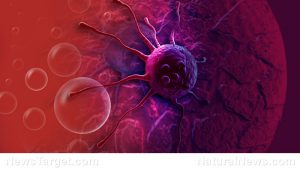
Myxoid chondrosarcoma – causes, side effects and treatments at NaturalPedia.com
Saturday, May 26, 2018 by Janine Acero
http://www.naturalpedia.com/myxoid-chondrosarcoma-causes-side-effects-and-treatments-at-naturalpedia-com.html

A myxoid chondrosarcoma refers to an infrequent, low-grade tumor found in both bone and soft tissues of the extremities, with the thigh being most common, followed by the knee, buttocks, and trunk. It typically affects men between 40 to 60 years old.
Most of these tumors form deep within the body tissues, though a few have been found beneath the skin surface.
Myxoid chondrosarcoma tumors can grow to large sizes and compress other tissues and organs, causing a restricted range of motion and sensation of pain, among other symptoms.

Known symptoms of myxoid chondrosarcoma
Myxoid chondrosarcomas don’t show symptoms in the initial growing phase. The thigh, knee, buttock, and upper extremities account for up to 80 percent of all occurrences, followed by the torso, chest, breast, and abdominal cavity.
The soft tissue tumors grow at a moderate rate, and then suddenly start rapidly progressing in size. The large size of the tumor may compress or restrict the adjoining organs, nerves, and muscles, which may cause a restricted range of motion. This symptom, along with pain and tenderness, is the first indication of the tumor.
- Pain – You might have an area that is painful or tender. It may be painful when you’re resting and is worse when you’re in bed at night. You could also have pain in a different part of your body from where the tumor is. This is called referred pain.
- Swelling – You might have some swelling instead of feeling or seeing a lump.
- Problems moving around – It might feel more difficult for you to move around. You might be walking with a limp.
- Exhaustion/fatigue – You might feel more tired than normal, even if you’re getting adequate sleep.
- Fever – You might feel feverish and have chills.
- A weakened bone – Although rare, you might have a weakened bone that breaks more easily. This is called a pathological fracture.
- Weight loss – You might be losing weight even if you haven’t changed your diet.
Body systems harmed by myxoid chondrosarcoma
Complications can arise depending on the site and severity of myxoid chondrosarcoma. These may include:
- Bone damage that may lead to limb amputations
- Lung and lymph node metastasis
- Tumors buried deep in the body tissues, which may create problems for adjoining tissues and organs by compressing them
- Blood loss during invasive treatment methods may be heavy; blood may accumulate outside the blood vessels
- Damage to vital nerves, blood vessels, and surrounding structures during surgery
- Side effects from chemotherapy (such as toxicity), radiation therapy
Food items or nutrients that may prevent myxoid chondrosarcoma
Here are some of the best herbs shown to have powerful anti-cancer properties without the damaging side effects of drugs.
- Astragalus or Huang Qi (Astragalus propinquus)
- Bloodroot (Sanguinaria canadensis)
- Cat’s claw (Uncaria tormentosa)
- Coneflower (Echinacea)
- Curcumin (Turmeric)
- Feverfew (Tanacetum parthenium)
- Goldenseal (Hydrastis canadensis)
- Milk thistle (Silybum marianum)
- Red clover (Trifolium pratense)
- Sheep’s sorrel (Rumex acetosella)
- Skullcap (Scutellaria)
- Wheatgrass
Stay away from these cancer-causing food additives:
- MSG
- Artificial sweeteners
- Added sugars
- High fructose corn syrup
- Partially hydrogenated oils
- Hydrogenated oils
- Food dyes
Treatments, management plans for myxoid chondrosarcoma
Treatment measures for myxoid chondrosarcoma include a combination of chemotherapy, radiation therapy, and surgical removal of the lesion. If the tumor has spread to the lymph nodes, a surgery may be needed prior to chemotherapy.
Vascular embolization of the tumor, by blocking the blood vessels feeding the tumor, is used to provide temporary relief from the symptoms and reduce blood loss, during a surgical procedure. Non-invasive procedures may be adopted if the tumor is at an inaccessible location, or is unsafe for surgical intervention.
Where to learn more
- Farmers at higher risk of developing various cancers caused by pesticide exposure
- Pesticides in the home will raise your child’s risk of getting cancer
- Large Study Shows Agent Orange Exposure Doubles Prostate Cancer Risk
- Chinese herbs kill cancer cells: study
- 6 Cancer-Fighting Culinary Herbs and Spices That You Should Know
Summary
A myxoid chondrosarcoma is an infrequent, low-grade tumor found in bone and soft tissues, with the thigh being most common, followed by the knee, buttocks, and trunk. It typically affects men between 40 to 60 years old.
Tagged Under: Tags: Myxoid chondrosarcoma





